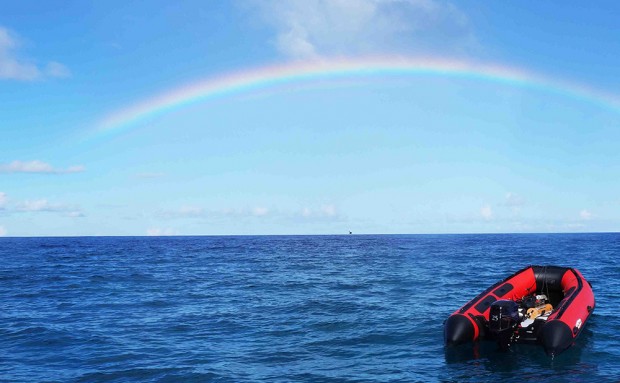2015 Darwin Science Expedition - Day 7 Gabriel and Danger

Charle’s has tried out a drone flight over some of the archipelago today. This should be great for recording aerial views of the shallow reefs – this test flight was fairly inconclusive as the sunlight was so bright the screen of the app for operating the camera on the drone could not be viewed by the pilot. So we’ll have to find some shade for the next attempt.

Diving operations are far more practiced now though with dive teams zipping in different directions to dive sites around the atoll. A couple teams headed outside of Ile Gabriel to a gently sloping coral garden. Catherine sampled a couple of coral heads for cryptofauna whilst Nick and Saun pursued their fish surveys.

The afternoons dives offered up something different. Within the Peros Banhos lagoon there are numerous knolls that slope up from the lagoon floor to within a few meters of the surface. Dropping in on one of these the coral gardens are phenomenal and the fish life overhead was abundant. An endless column of fusiliers of different species flowed by throughout our dive here whilst a large snout spotted grouper glared at us watchfully as he lurked between coral hideaways.

Another stunning day although the wind has picked up a little. The weather over the last few days has lent itself to work on the islands. Pete has a written a few more paragraphs to fill you in on the details...
.jpg)
The overnight passage north from Diego Garcia to Peros Banhos was very calm and accompanied by a beautiful sunset. It also afforded me the opportunity to gather more records of seabirds at sea and cetaceans. In addition to the constant stream of Red-footed Booby, Brown Noddy and Fairy Terns (Gygis alba) heading south to Diego Garcia to roost, three Bulwer’s Petrel were encountered foraging over the glassy sheen of the tranquil seas. It was surprising seeing this species in the Chagos at this time of the year when theoretically it should have returned to its breeding islands in late March / early April; the nearest thought to be Round Island, Mauritius. As the sun finally dropped below the horizon a pod of 10-20 Common Dolphin came to ride in front of the ship. A wonderful ending of the first day at sea.
a_0.jpg)
As the sun rose again the following day the ship was nearing the rocky island of Coin de Mire. This elevated, sparsely vegetated limestone outlier of Peros Banhos atoll, along with the similar Resurgent Island on the western rim of the Great Chagos Bank are the only islands that the magnificent Masked Booby breeds on. Both Resurgent and Coin de Mire are exceedingly dangerous to land on but, with calm seas offering a rare opportunity to conduct an accurate census of the breeding seabirds, Jon Slayer and I thought we would try our hand. Jon thought he would add to the challenge of getting on the island by bringing along his Google Trekker recording equipment!
a_0.jpg)
The Masked Booby colony was faring well with 24 occupied nests, nearly all having laid their two eggs. Bridled Tern, another rare breeding species in the archipelago had 21 breeding pairs present, the highest count of any island ever. As a fitting finale there was a single pair of Roseate Tern present that were protecting a nest or chick. A beautiful species in breeding condition with the glaring whiteness of the birds being complimented by pink suffused underparts, less than 10 pairs breed annually in the Chagos.
a.jpg)
After anchoring in the southwest of the atoll the most important task of the expedition was facing me. In August 2014, accompanied by a professional mammal eradication expert from New Zealand and a small team of military volunteers from the British Forces on Diego Garcia, the small island of Vache Marine had its’ introduced invasive rats removed. Conducting this type of operation on tropical islands is still fraught with possibilities of failure and worldwide teams doing this type of work are managing about 80% success. My task whilst while the ship was anchored for three days in the southwest of this atoll was to conduct a first check to see if our work had failed. With some trepidation I set off for Vache Marine to set traps and conduct visual observations. I am glad to say that after three days of checking including one overnight stay with observations being made throughout the night, I saw no sign of rats. It is too early to say the eradication has been successful but, pleasingly, I can say there is no reason to date to believe it may fail. Further checks around August 2016 will reveal the final verdict.
a.jpg)
Claudia again joined me ashore on Vache Marine for some of the time. Together we removed the bait stations that were left on the island (a hard and hot task!) as part of the eradication project and before we left, Claudia planted a small native tree. This tree was grown from a seed collected by a British soldier, nurtured on board by the crew of the BIOT Patrol Vessel for twelve months and finally planted by a visiting Chagossian. It was a poignant and symbolic gesture of how with goodwill and coordination terrestrial environmental improvements can be made in the Chagos Archipelago and was a fitting end to this part of the expedition.

